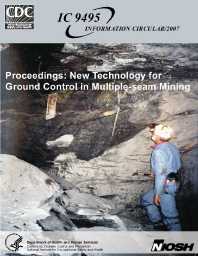Mining Publication: Multiple-Seam Mining Interactions: Case Histories from the Harris No. 1 Mine
Original creation date: May 2007
The Harris No. 1 Mine in Boone County, WV, has been longwalling the Eagle Coalbed for over 30 years. Harris has experienced numerous interactions associated with the extensive room-and-pillar and longwall mining operations that have been conducted in the overlying No. 2 Gas Coalbed. The problems have included roof falls, excessive rib sloughage, and gate road and bleeder entry closure. A detailed evaluation of the multiple-seam experiences at Harris No. 1 Mine was done as part of NIOSH's nationwide multiple-seam mining case history database. One observation was that smaller, critically loaded, upper-seam pillars seemed to cause more severe ground conditions than wider pillars. The LaMODEL program was used to investigate this. Results confirmed that critical-sized pillars transmit the highest amounts of stress to adjacent seams. In addition, the data suggest that the probability of a major multiple-seam mining interaction increases when the depth of cover is 1,000 ft or greater and when the Eagle Seam pillars have an ALPS stability factor of less than 1.50.
Authors: FE Chase, P Worley, C Mark
Information Circular - May 2007
NIOSHTIC2 Number: 20032067
Proceedings: New Technology for Ground Control in Multiple-Seam Mining. Mark C; Tuchman RJ, eds., Pittsburgh, PA: U.S. Department of Health and Human Services, Public Health Service, Centers for Disease Control and Prevention, National Institute for Occupational Safety and Health, DHHS (NIOSH) Publication No. 2007-110, IC 9495, 2007 May; :63-71
See Also
- Behavior of a Coal Pillar Prone to Burst in the Southern Appalachian Basin of the United States
- Field Observations and Numerical Studies of Horizontal Stress Effects on Roof Stability in U.S. Limestone Mines
- The Ground Response Curve, Pillar Loading and Pillar Failure in Coal Mines
- Knowledge Management and Transfer for Mine Emergency Response
- Multiple Seam Mining Interactions: Case Histories from the Harris No. 1 Mine
- Pillar Stability Issues Based on a Survey of Pillar Performance in Underground Limestone Mines
- Proceedings: New Technology for Ground Control in Multiple-seam Mining
- Reducing the Risk of Ground Falls During Pillar Recovery
- Sizing of Final Stumps for Safer Pillar Extraction
- Stability Analysis of a Backfilled Room-and-Pillar Mine
- Content source: National Institute for Occupational Safety and Health, Mining Program


 ShareCompartir
ShareCompartir
